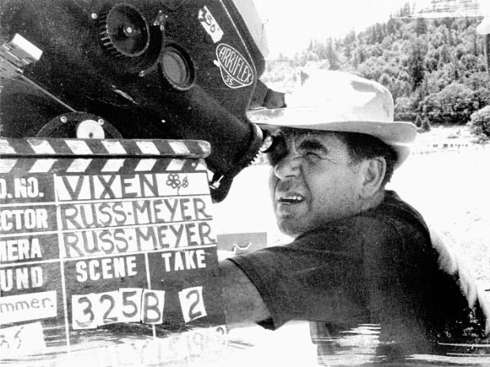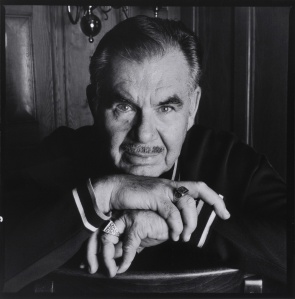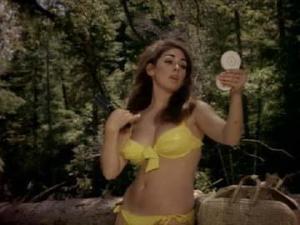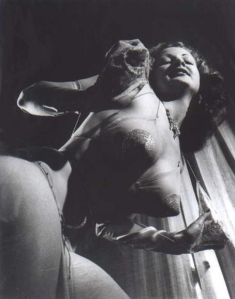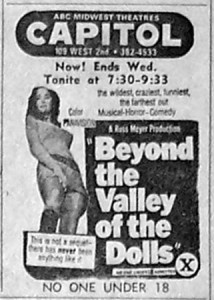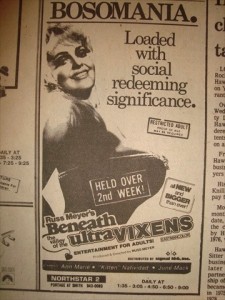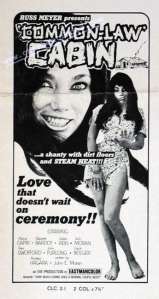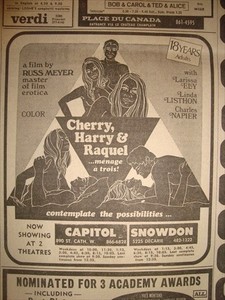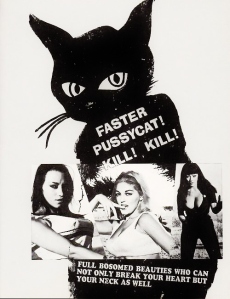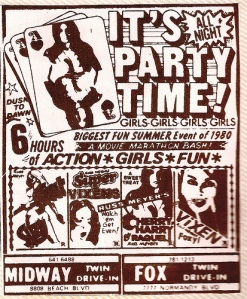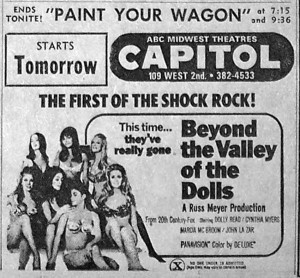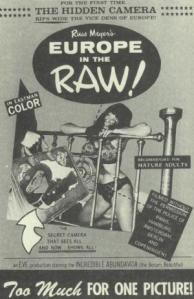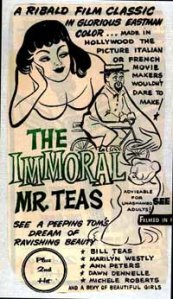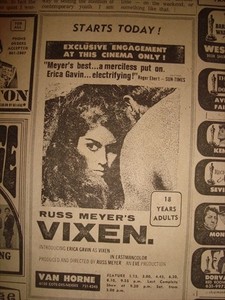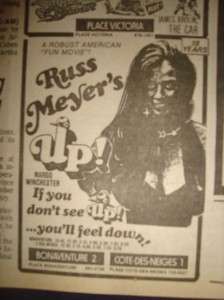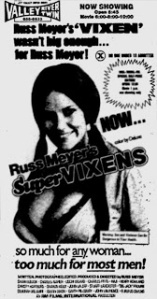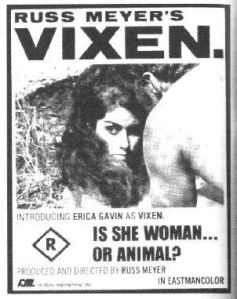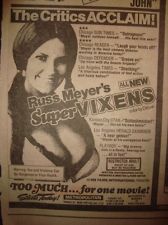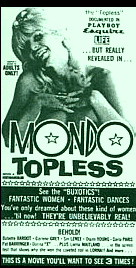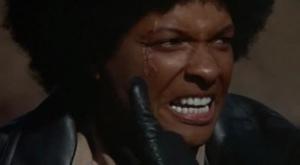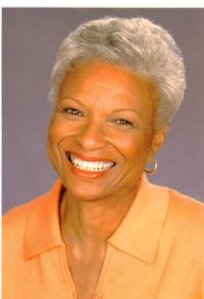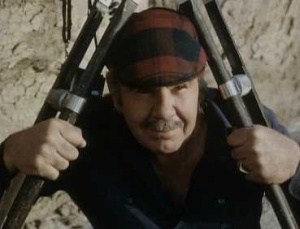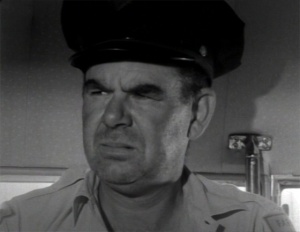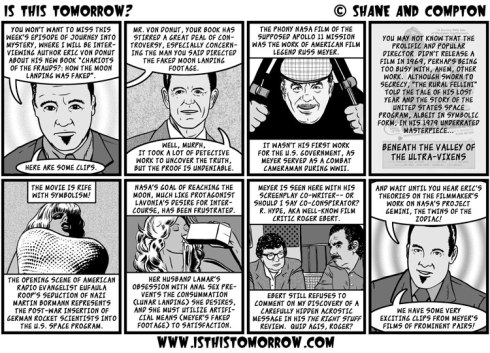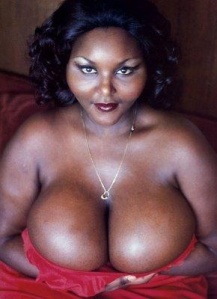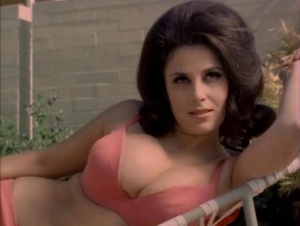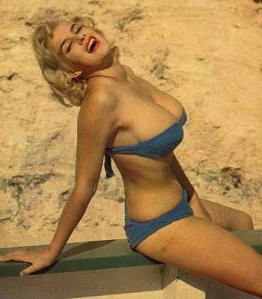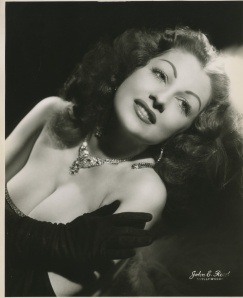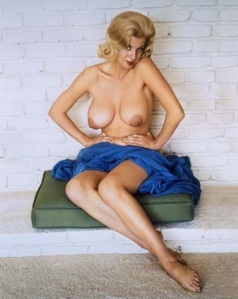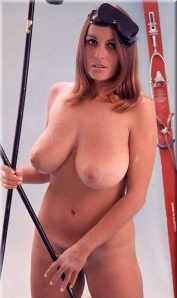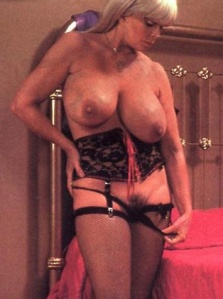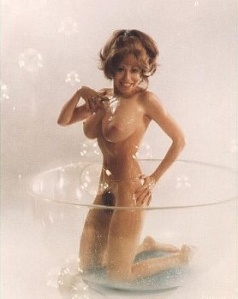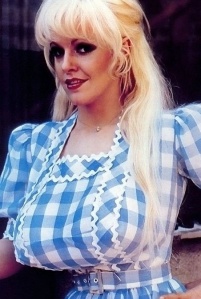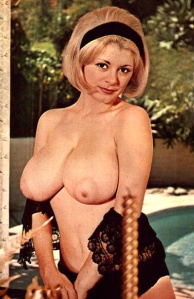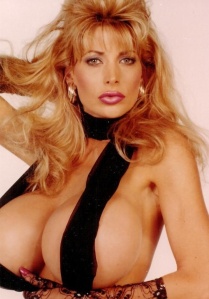I have always been intrigued by actress Lavelle Roby. Ever since watching
Beyond the Valley of the Dolls for the first time, I have often thought about her character Vanessa, the assistant to music producer extraordinaire Ronnie ‘Z-Man’ Barzell. In a film that is full of wonderful costumes, her black and gold dress has always stood out for me and I’ve wondered on more than one occasion, that if the film were real, what her job must have been like. I’m sure that Vanessa would have a story or two about Z-Man and his parties! After I watched
Finders Keepers, Lovers Weepers a few years later, I was captivated again by Roby’s performance. In another small-ish role, she managed to be the most captivating actress in the entire picture and certainly the film’s highlight. Her character Claire is one of the stronger female characters in Russ Meyer’s entire filmography. The girl is a total badass, running her own business, not afraid to treat men the way they treat women and ready to get stuck in whatever the situation. It really is a shame that Meyer never used Roby in a leading role, for after watching her as Claire it’s evident that she could quite easily have held her own against the likes of Tura Satana and Kitten Natividad. Personally, I would have loved to have seen a venomous exchange of words between her and Alaina Capri. Two of Meyer’s savviest actresses going head to head in verbal battle? Sounds absolutely perfect. After a little investigating I was really happy to see that Lavelle is
still acting and modelling and still looks as drop dead gorgeous as she did in the 1960s! She kindly agreed to answer some questions, see below, for which I am very grateful. As my friends and readers will know, I’ve been a huge Meyer fan since I was ten (fourteen years and counting) and a majority of this website is nothing but a labor of love for me. I am more than thrilled, excited and humbled that I’m finally playing host to my first Meyer girl, it’s been a dream come true! Many thanks to Lavelle and to everyone who reads this, enjoy!
How did you get into acting?
I had studied Speech and Drama in college and had continued drama classes and modelling school while working full-time in sales. When I left the company I had worked for after five years, I decided to concentrate on modelling. I had begun my career in 1963 but it wasn’t until 1966 that I decided that modelling and acting should be my career path. Actually, it was an abusive breakup that helped me make the transition. I probably wouldn’t have left the job when I did had I not been forced to go into hiding when I broke up with an abusive lover who was a co-worker. So, I guess I owe him a debt of gratitude for forcing me to take the leap. I could have still been taking acting classes and not having the courage to go for it had I not been forced to. I was the highest paid woman in my job, I was the Assistant Sales Manager of a Food and Freezer Company. I worked in a sales office with about sixty salesmen. That office made the movie Glengary Glen Ross look like kindergarten. As a matter of fact, one of my one person shows is based on one of the characters from that period. My e-mail address, egnapos (Every Girl Needs a Pair of Stockings, registered title ) is also from that period. Eventually my first acting role was the TV show Get Smart.
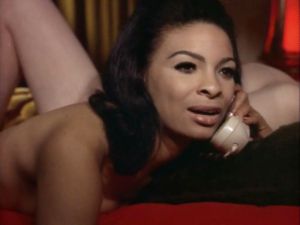
It’s very interesting that my first film was with Russ Meyer. I don’t really remember how I first heard about the film, however, when I called my agent to ask him to submit me for the role of the madame, my agent laughed at me and told me that Russ would never hire me because Russ only hired big breasted girls. Since my breasts were only a small B cup, he didn’t want to submit me. I pleaded with him to give it a try, because if Russ would only let me come in to read for the part, I would surely convince him that I could handle the role. Indeed, I read for the role, Russ loved the reading and hired me. According to Russ himself, I was the first actress he had ever auditioned that had not had to show her breasts to audition for a role!
Talking of breasts, you show a fair amount of flesh in the film but it’s considerably less than the amount seen of co-star Anne Chapman. What was your stance on nudity and how comfortable did Meyer make you feel on set?
Russ had been famous for travelling the world over to find women with the biggest and best breasts. He was very careful in shooting me and not revealing too much flesh. And, while Anne was not a great actress, she did have a great set of tits! Working with Russ was a great pleasure. He was respectful, hard-working, and had a great sense of humour.
I think you were also the first Black actress that Meyer ever hired, how does that make you feel?
I never gave any thought to being the “first” other than the first woman Russ had hired who didn’t have big breasts. I was just proud that he had hired me for my acting ability rather than my body.
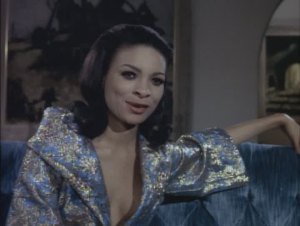
As Claire you get to wield a gun and rock a great looking outfit made up of a mack and go-go boots. With Finders being such a small production, did you have much say in how Claire looked? I know that quite a few of Meyer’s actresses had to do their own hair and makeup…
The thing that almost drove me mad was that I wouldn’t let anyone do my makeup, however I gave in and allowed the makeup man to do it. Well, when he was putting on my false lashes he got glue in my eye. As a result, the eye ran the entire day and the eyelash glue wouldn’t stick. When it was time for my closeups, all I could think about was they everyone would be able to see this flapping false eyelash that had come unglued at the edge!
The cream outfit and the go-go boots were my own wardrobe. I had a close friend, Tommy Roth, who designed for Little Richard, and he designed that outfit. Tommy was gay and a cross dresser. He made new outfits for himself every time he went out. He would only wear the outfit once. Because we were the same size, I got a lot of new designs from him. He would also borrow my things, but the skirts would be returned altered – pencil thin where I could hardly walk!
Do you have any fond on-set memories or stories from working on Finders Keepers?
The most memorable moment was the day I was on my way to the wardrobe designer. A few blocks from my house a policeman, whom I knew from the neighborhood, stopped me to flirt, as he usually did. I had a few minutes, so I didn’t mind. But, after a while, I was running out of time and was soon going to be late for my wardrobe fitting when the officer said “I must call in to see if I have a warrant out for your arrest.” I said I need to leave because I don’t have any more time. He was just stalling for time. He didn’t really think I had a warrant, but since he had said that, he had to follow through. Much to his surprise, indeed, there was a warrant for my arrest. I went ballistic!
This scene takes place at one of the busiest intersections in Los Angeles. I am dressed in a micro-mini (more like a short blouse). I am out of control! Enraged! Practically foaming at the mouth! The officer doesn’t know what to do. He has to call for backup because I am now this crazy woman in the middle of the street in a rage. The pages of the script were flying everywhere. Finally the backup officers arrive. Now my neighborhood officer has to explain why he stopped me… I wasn’t speeding. My licence was in order. But he explains that my vehicle identification number looked like it had been changed.
I finally calmed down and explained that they would have to somehow reach the producer (Russ) who I am meeting at the designer’s studio. When they found out I was an actress, they were very accommodating. They did indeed locate the studio through a cross directory and let Russ know that they had arrested me, but it wasn’t serious. It had been a parking ticket that my former boss’s son had received when he had borrowed my car and failed to let me know that he had gotten the ticket. Fortunately, the ticket was only $10, which I paid and then they released me.
You returned to work with Meyer again on 1970 release Beyond the Valley of the Dolls, what was your experience working on this like compared to Finders Keepers?
Some of the people who worked on Beyond the Valley of the Dolls had previously worked with Russ. Of course, Beyond the Valley of the Dolls was with 20th Century Fox and the cast was very large. And orchestrating a large cast of people was very different from the small, intimate sets that he had been used to when he was making a Russ Meyer film. A studio film environment was very different and there were people there looking over his shoulders, publicity people. There were business voyeurs, photographers, extraneous people that wouldn’t have been present on a smaller Russ Meyer set.
Did Meyer specifically ask you to play Vanessa or did you have to again read for the part?
Russ hired me for Beyond the Valley of the Dolls specifically to play Vanessa.
What were your impressions of the film when you eventually watched it?
While the film may have seemed like an exaggeration or a little over the top, on the contrary, Russ captured the mood of the times. Sex, drugs, rock and roll, the bizarre; he captured it all. But Russ had a way of putting it in your face, up close and personal. Mainstream America wasn’t ready for that kind of honesty. Mainstream America had this puritanical morality. It’s a deceptive morality, like the Catholic Clergy committing horrible crimes against children but hiding it, and at the same time pretending to be the moral conscience and leaders of the faith. I think that which makes Russ’ film such a cult classic is not just because of the nudity, but the great sense of humour. The people who love him and his work get it, they get the “explicit” humour in the excessiveness.
The ending very much echoes the, at the time, recent Tate-LaBianca Manson murders. I know some people on the set of Beyond knew Sharon Tate and Jay Sebring and that some of the costumes used were Sharon’s actual costumes from the film Valley of the Dolls. Did you know any of the victims yourself from working in Hollywood?
I didn’t know any of the people personally, however, I have friends that were neighbours, relatives and friends of some of the victims. I knew the very first attorney that was on the Manson case.
Given Hollywood’s fondness for remakes and re-imaginings, do you think Beyond could ever be remade?
Anything is possible in Hollywood.
They are both small-ish roles but Vanessa and Claire are both highly memorable. Which character is your favourite?
With both Claire and Vanessa there was something about both characters that I believe they shared, freedom and loyalty as friends.
Meyer was known for working multiple times with much of his cast and crew, how often did the two of you work together?
I had the fortune to work with Russ on Finders Keepers, Lovers Weepers!, Beyond the Valley of the Dolls, The Seven Minutes and I did the entire voice track for another actress who met the breast requirement, however, her voice was terrible and had to be dubbed. I’ve forgotten the movie title but the character was Junk Yard Sal (the film Roby is referring to is Beneath the Valley of the Ultravixens, the actress is June Mack – Lydia). Russ called me in to dub the film. It was great fun! I was able to do all the sexual things without actually being seen. When Russ screened the film, as we were walking out of the screening, I overheard the actress talking to one of her friends excitedly, “I had no idea I sounded that good.” She never knew that it wasn’t her voice. I was very proud that I had captured her rhythm well enough that she didn’t even know that it wasn’t her voice! In real life she was an S&M professional (sadomasochist professional). She was murdered not long after the movie was made. I’m not sure if the crime was committed by one of her clients or not (it is well-known, but also apparently proven wrong, that Mack was murdered by one of her clients – Lydia).
Did you keep in touch with Meyer after working with him?
I always stayed in touch with Russ. As a matter of fact, many of us did, male actors as well. He was well liked and respected deeply. We had reunions and also, the people he worked with, including his crew, were his friends. Some of his crew were his old war buddies.
Are reunions still something that happens now that Russ has sadly passed?
The last time the Meyer girls got together was at Russ’s memorial service. We all got together afterwards and shared stories. We said that we would continue to get together. Unfortunately, we didn’t.
Are you close to any other Meyer alumni?
The only person that I have remained in touch with is Harrison Page (Vixen!, Beyond the Valley of the Dolls). As a matter of fact, Harrison and I are both members of the SGI, a worldwide Buddhist organization. I started practicing Buddhism 40 years ago, and as a new member, I introduced Harrison to the practice.
You also worked with Melvin Van Peebles on Sweet Sweetback’s Baadasssss Song, what was that experience like?
Working with Melvin Van Peebles was totally different! First of all, for the role in Sweet Sweetbacks Baadasssss Song, I had no script. I created the dialogue myself. Melvin told me what he wanted and it was left up to me to create that. It was improvisational. We shot until he got what he wanted.
Did you notice any similarities/differences between Van Peebles and Meyer in their approach to filmmaking?
I found no similarities in Meyers style to Van Peebles. I worked with Van Peebles on Sweetback as a favour. It was my only experience working with him and it was a frustrating experience. I am proud of the role I created, but much of the anger and frustration came out of the moment. There was nothing comfortable about the experience. But perhaps that’s what it was supposed to be. Sweetback was “raw.”
Was improv something that came naturally to you?
Creating the improvisational role was very easy for me because in my acting training we did lots of improv work. I trained in a form of the Method called Transpersonal and had studied with Ned Manderino who wrote several books, The Transpersonal Actor, All About Method Acting and others.
What have been your favourite acting jobs?
All of my acting jobs are my favourite acting jobs. Every single one, from the smallest to the largest, I have enjoyed doing the work. But there are those that have a more memorable story, like for example working on The Formula with Marlon Brando. I had eleven days with just Brando, myself and George C. Scott. Watching Brando do his “Brando” thing was amazing. I really learned from that experience that you didn’t have to be sane to be a brilliant actor. I also learned that if you surrounded yourself with people who couldn’t or wouldn’t say no to you, that it’s impossible to remain in the world of reality.
Scott and Brando aside, you’ve worked with many veteran and talented actors. Was there anyone else you worked with, in either film or television, who was particularly memorable?
I was working on a TV show, I think it was Equal Justice, and the director gave the actor Joe Morgan the highest compliment I had ever heard a director give an actor. He said to Joe, “You are never not on.” That had a profound impact on my life. As a matter of fact, it changed how I approached my work. Up to that time, as we were rehearsing a scene, I always held back just a little bit. I would never give it my all until we were ready to shoot. But after that, I never held back. Each time, even when we are rehearsing, I gave it my all, and by doing so, I discover something new. So, thanks to Joe Morgan, I always try to,”never not be on.”
Meyer was known for keeping souvenirs from his films and had an extensive archive of publicity material. Have you ever kept anything from the projects you’ve worked on?
I haven’t ever kept anything from any film that I have done. I only have publicity photographs from a movie for tv, The $100,000 Opportunity, which won a Local Emmy for CBS Repertory Workshop. It was a three character script.
Do you get recognised much because of your work, be it acting or modelling? I know a few people who recognise you from your cameo in Rocky (Roby makes an appearance as Mary Anne Creed).
Because of the amount of modelling work that I do, I get recognized more for modelling. My face is literally seen everywhere! And because its lifestyle, people see me in their doctor’s office, at their drug store, advertising their resort, and on and on… I am the queen of health care and medicine! I don’t believe there is any other African-American female in my age category that advertises more in print than I do. My dream was to become the African-American Carmen. She’s my inspiration.
With my acting, people are seeing a lot more of my earlier work in reruns. Now they are like, “Oh, I saw you in something last week.” For example, there was a marathon of the Planet of the Apes films. I did two of those. As I switching channels, I saw myself in one of them. Just a few minutes afterwards someone called me from another state to say that they had seen me in a Jim Brown film that I had done. There are so many cable channels so the need for material is beyond belief.
Were you ever asked to come back to play Mary Creed in the other Rocky films?
I was never asked to come back to play Mary Creed. I think Apollo Creed was based loosely on Ali. Ali married several times. I knew the woman who played the second wife. We often competed for the same roles, especially in commercials. She passed away recently.
You did a biker movie in 1971 (The Peace Killers), another blaxploitation flick in 1972 (Black Gunn), a franchise (Planet of the Apes) and a comedy (Love at First Bite). Is there anything you havent done that you’d love to do?
I’ve yet to do a serious drama. I want to do that. I would like to do something serious enough that I can win an Academy Award. I still have time. Ruth Gordon was 80 when she won her award! I’ve still got a few more years!
You’ve also worked in theatre and modelling, what are your working passions now?
I have modelled since 1963 and continue to do so because I love the work. What I love most is how many people I am able to encourage because they say “I see your face everywhere,” and they are encouraged by that. Or that a relative can see my face on some ad on their computer and they are inspired by it. It encourages me that I am still modelling after fifty years and am still kicking! I am now working towards perfecting my V.O. skills. I’m also rewriting some one woman shows that I created a couple of years ago that I want to make some changes to. And lastly, there are some novels that I started, but haven’t completed. I have still much to do! And so little time to do it all!
Tags: Beneath the Valley of the Ultravixens, Beyond the Valley of the Dolls, Breast fetish, Finders Keepers, Lovers Weepers!, Lavelle Roby, Russ Meyer, Sexploitation, The Seven Minutes
